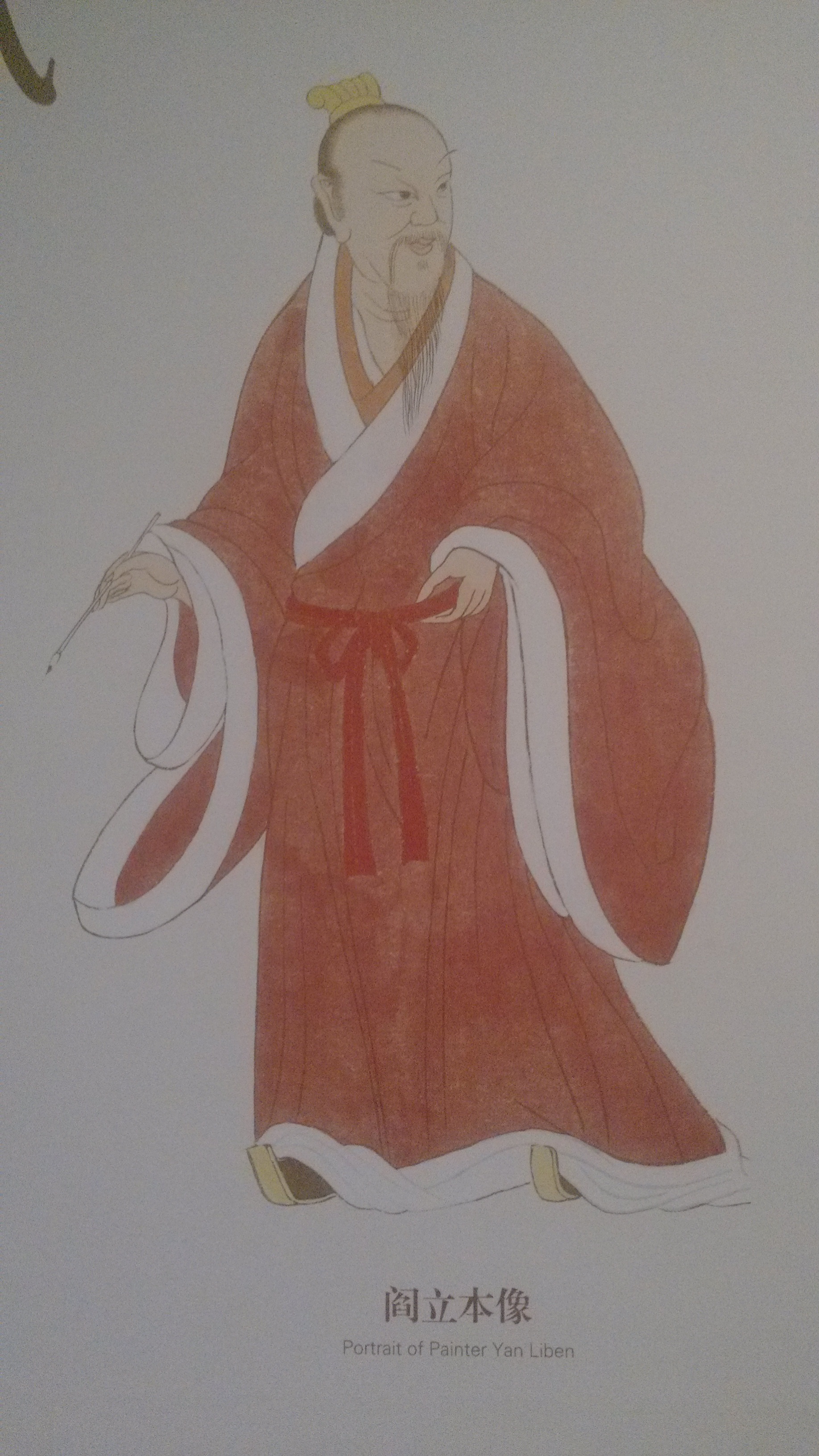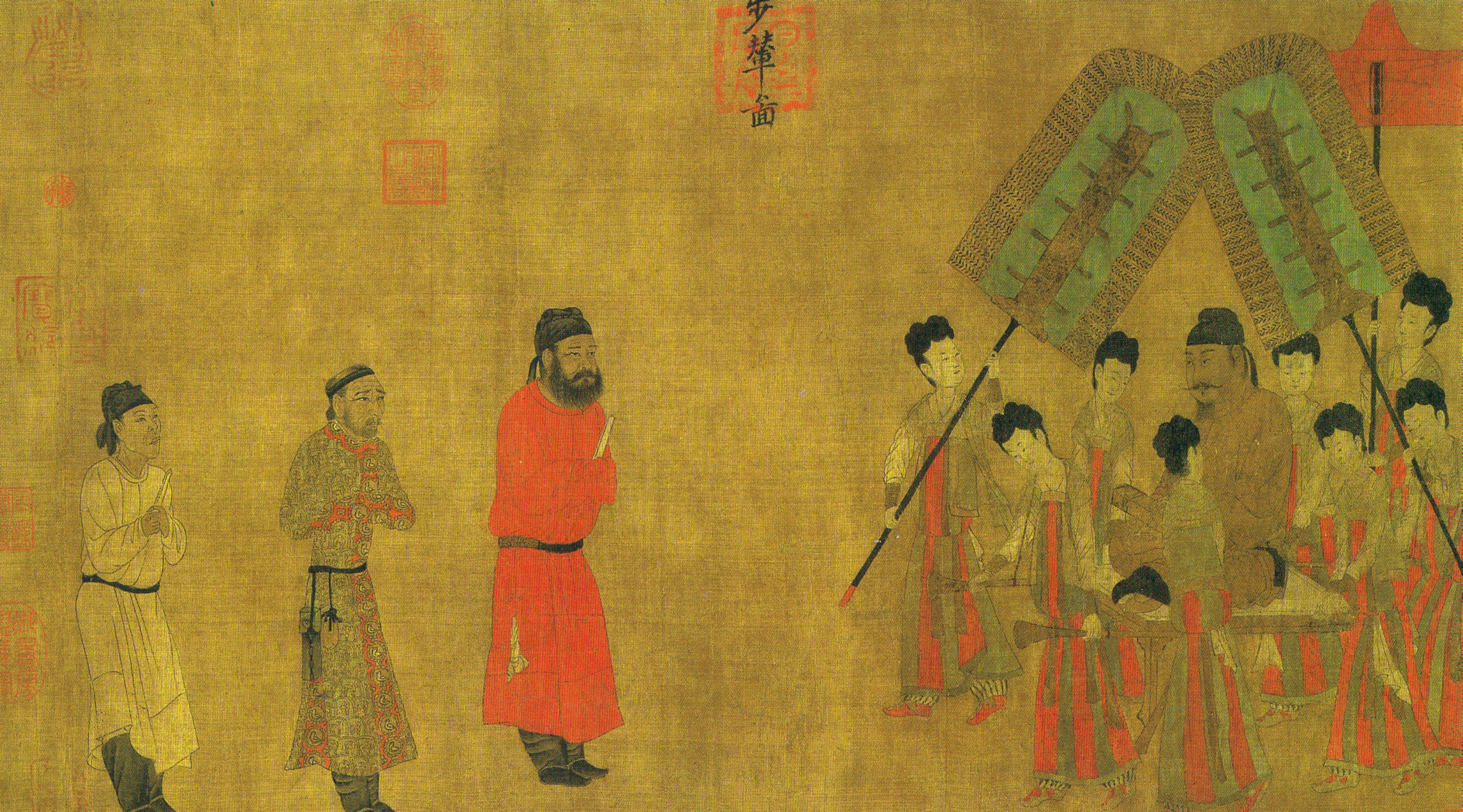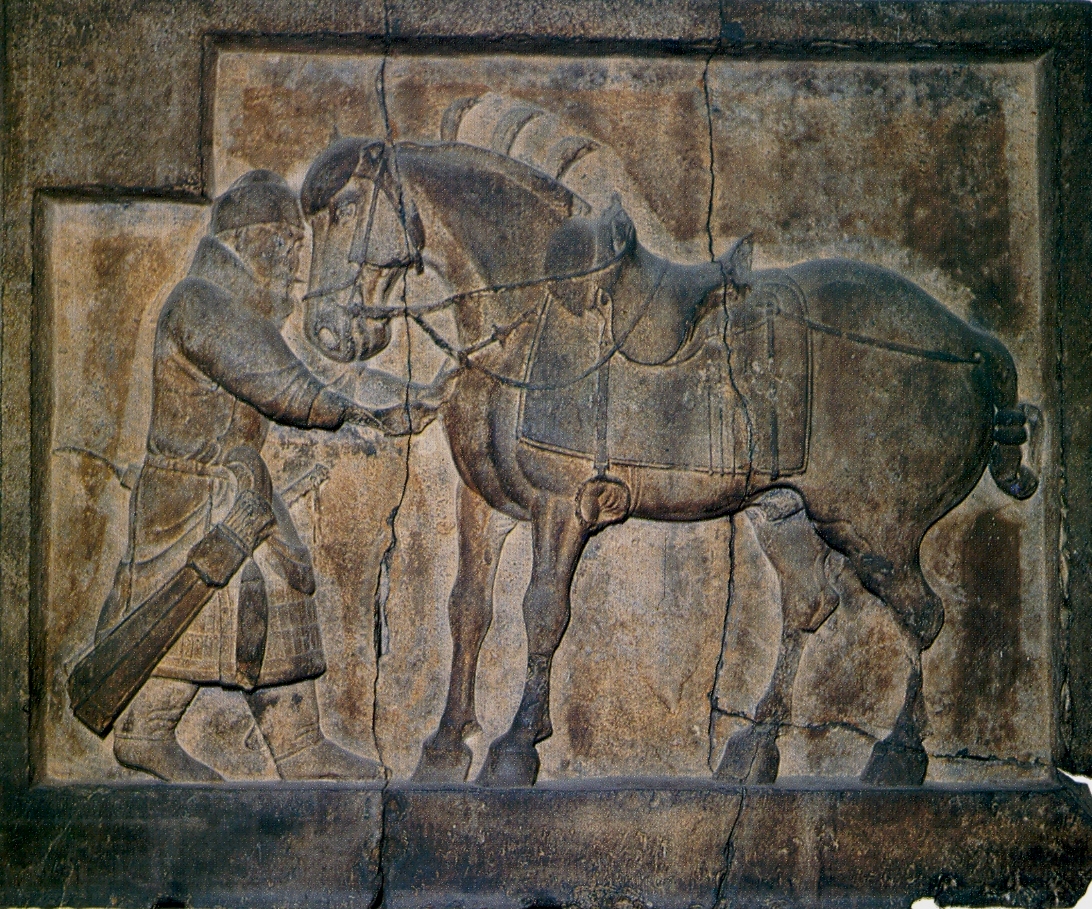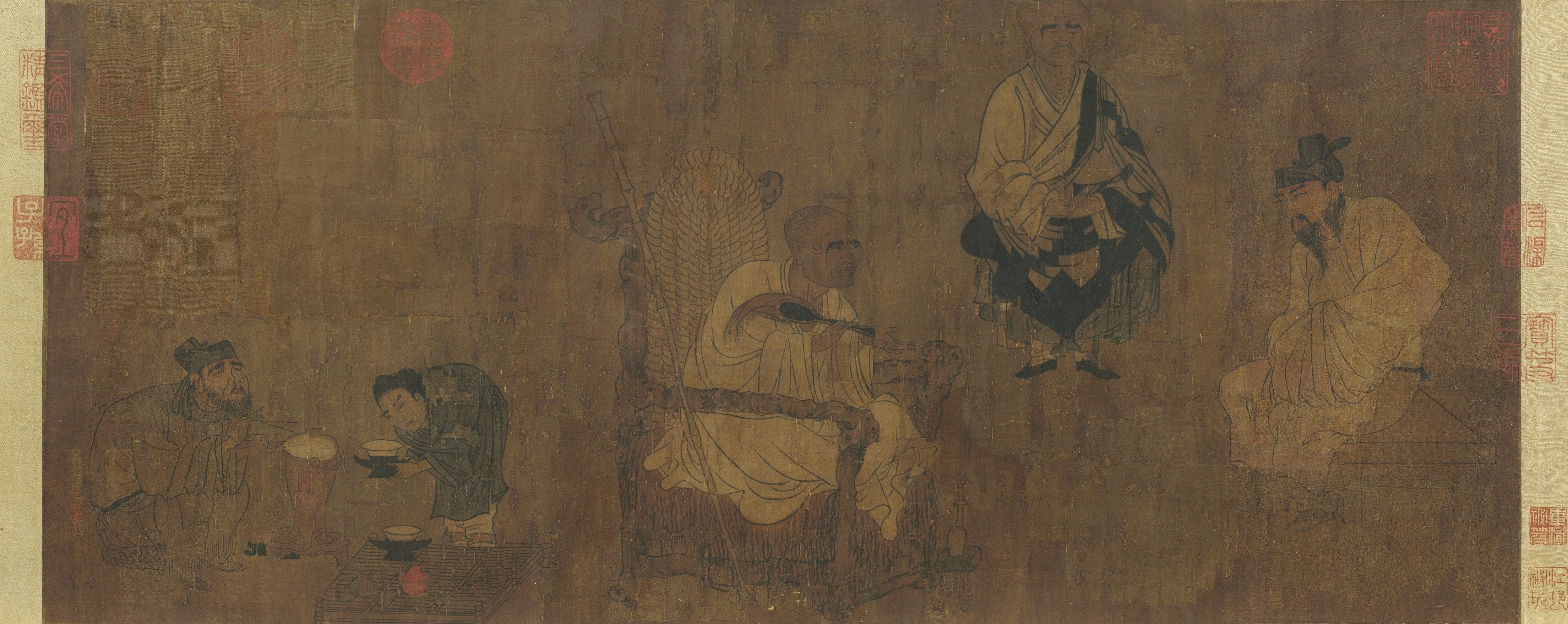1. Overview
Yan Liben (閻立本Yán LìběnChinese), born in 601 and dying on November 14, 673, was a prominent Chinese architect, painter, and politician who served during the early Tang dynasty. Formally known as the Baron Wenzhen of Boling, he is celebrated for his significant contributions to both art and government. His artistic legacy includes renowned works such as the Thirteen Emperors Scroll, a collection of portraits of various Chinese emperors, and the Portraits at Lingyan Pavilion, commissioned by Emperor Taizong of Tang to commemorate his reign's greatest contributors. Yan Liben's paintings, which depicted emperors from the Han dynasty through the Sui dynasty, were highly praised by contemporary Tang writers, who described them as "works among the glories of all times." Beyond his artistic endeavors, he held high-ranking political positions, including serving as a chancellor under Emperor Gaozong of Tang from 669 to 673.

2. Early Life and Background
Yan Liben's early life was shaped by a distinguished family background and a natural inclination towards the arts, influenced by his father and elder brother.
2.1. Family and Ancestry
Yan Liben was born in 601. His ancestors originated from Mayi (馬邑), located in modern Shuozhou, Shanxi province, but had relocated to the Guanzhong region, specifically around Chang'an, several generations before his birth. His father, Yan Pi (閻毘Chinese), served as the deputy director of palace affairs during the Sui dynasty. His elder brother, Yan Lide (閻立德Chinese), was also a notable figure known for his architectural prowess and administrative service to the imperial government. Yan Liben's mother was Qingdu Princess, a daughter of Emperor Wu of Northern Zhou, making him a nephew of Emperor Xuan of Northern Zhou and a cousin of Emperor Jing of Northern Zhou.
2.2. Artistic Training and Influences
Yan Liben displayed artistic talent from an early age. Both his father, Yan Pi, and his elder brother, Yan Lide, were accomplished painters and successful administrators at court, and they played a crucial role in training Yan Liben. His father died at the age of 49. Yan Liben grew up in Chang'an and initially collaborated with his elder brother on at least two recorded works. While his brother Yan Lide was known for his "white painting" (白画haku-gaJapanese), a style focusing solely on lines, Yan Liben developed a preference for figure painting, influenced by artists such as Zheng Fashi. His family's expertise in various crafts, including palace decoration, official attire, chariot design, and civil engineering, further contributed to his diverse skills.
3. Artistic Career
Yan Liben's artistic career was marked by his exceptional skill in painting, particularly portraits and historical scenes, which earned him high acclaim during the Tang dynasty.
3.1. Major Works
Yan Liben's oeuvre includes several highly significant paintings that have left a lasting impact on Chinese art history.
His most famous work is the Thirteen Emperors Scroll (歷代帝王圖卷Chinese), which is believed to be the only partly original work attributed to him that survives, though much of it appears to be a later copy, likely from the Song dynasty. This scroll depicts thirteen emperors from the Western Han dynasty to the Sui dynasty. The emperors featured include:
- Emperor Zhao of Han (漢昭帝Chinese)
- Emperor Guangwu of Han (漢光武帝Chinese)
- Emperor Wen of Wei (魏文帝Chinese)
- Emperor Da of Eastern Wu (吳大帝Chinese)
- Emperor Zhaolie of Shu (蜀昭烈帝Chinese)
- Emperor Wu of Jin (晉武帝Chinese)
- Emperor Xuan of Chen (陳宣帝Chinese)
- Emperor Wen of Chen (陳文帝Chinese)
- Emperor Fei of Chen (陳廢帝Chinese)
- Emperor Houzhu of Chen (陳後主Chinese)
- Emperor Wu of Northern Zhou (北周武帝Chinese)
- Emperor Wen of Sui (隋文帝Chinese)
- Emperor Yang of Sui (隋煬帝Chinese)

Under the commission of Emperor Taizong of Tang, Yan Liben painted the Portraits at Lingyan Pavilion in 643. This series commemorated 24 of the most significant contributors to Emperor Taizong's reign. He also created 18 portraits honoring the great scholars who served Emperor Taizong when he was the Prince of Qin, a work known as the Qinfu Eighteen Scholars (秦府十八学士図Japanese), with inscriptions by Chu Liang.
Another notable work attributed to him is Emperor Taizong Receiving the Tibetan Envoy (步輦圖Chinese), which likely dates to Emperor Taizong's reign and is also considered a later copy, possibly from the Song dynasty.


By tradition, the reliefs of the Six Steeds of Zhao Mausoleum, depicting six favorite horses at the mausoleum of Emperor Taizong, were designed by Yan Liben. The flat and linear style of these carvings suggests they were created based on his drawings or paintings. One of these famous reliefs is "Saluzi" (颯露紫Chinese), also known as Autumn Dew. Yan Liben is also documented as having produced other works for the tomb, including a now-lost portrait series, and may have designed the entire structure.

Other attributed works include Xiao Yi Acquiring the "Orchid Pavilion Preface" by Deception (蕭翼賺蘭亭圖Chinese) and Portraits of Periodical Offering of Tang (王會/職貢圖Chinese), which depicts foreign envoys presenting tribute, also likely a Song dynasty copy.


A record from 1120 lists 42 titles of Yan Liben's paintings, though the Thirteen Emperors Scroll is not among them. This list includes only four Buddhist subjects, compared to twelve Daoist ones, with the remainder being portraits, depictions of "gods of the planets and constellations," or records of court events.
3.2. Artistic Style and Techniques
Yan Liben was particularly renowned for his figure paintings and portraits, demonstrating exceptional skill in capturing the likeness and character of his subjects. His painting style is characterized by thin, strong, and meticulously continuous lines, which represent a continuation of traditional Chinese painting methods. During this era, the social function of art, particularly in demonstrating royal authority, was highly emphasized, leading to a suppression of individual expression in favor of established techniques.
His traditional approach stood in contrast to the emerging Western Regions (西域Chinese) painting style, exemplified by artists like Yuchi Yiseng (尉遲乙僧Chinese), who introduced new influences. Despite these new trends, Yan Liben's traditional and powerful linear drawing style was highly influential and was later inherited and continued by artists such as Xue Ji (薛稷Chinese).
3.3. Anecdote on Artistic Identity and Social Status
An illuminating anecdote highlights the social perception of painters during Yan Liben's time. On one occasion, while Emperor Taizong of Tang was enjoying a boat ride with his attendant scholars at the imperial pond, he observed birds flying by. The Emperor commanded his scholars to compose poems about the scene and then summoned Yan Liben to paint it. At this time, Yan Liben was already a mid-level official, holding the position of Zhujue Langzhong (主爵郎中). However, when the imperial attendants called out, "Summon the imperial painter, Yan Liben!" he felt a deep sense of shame.
Upon returning from this task, running around and sweating as he sketched by the pondside in front of numerous guests, Yan Liben expressed his humiliation to his son. He remarked, "I studied diligently when I was young, and it was fortunate that I managed to secure an official position and gain recognition for my abilities. However, now I am known only for my painting skills, and I am reduced to serving like a mere servant. This is truly shameful. Do not pursue this skill." Despite his personal feelings about the social status of painters, Yan Liben's passion for art persisted, and he continued to paint even after this incident. This story underscores the prevailing social hierarchy where artistic professions, despite their importance to the court, were often viewed as inferior to administrative roles.
4. Political Career
Beyond his artistic achievements, Yan Liben had a distinguished political career, serving in various administrative capacities and rising to high positions within the Tang government.
4.1. Early Official Service and Public Works
Yan Liben was not only skilled in painting but also proficient in public works projects. His early administrative contributions included collaborating with his elder brother, Yan Lide, on architectural matters. He initially served as an imperial architect during the Xianqing era (656-661) of Emperor Gaozong of Tang's reign.
4.2. Service under Emperor Taizong
During the reign of Emperor Taizong of Tang, Yan Liben's primary responsibilities included major artistic commissions for the court, as detailed in his artistic career. These included the creation of the Portraits at Lingyan Pavilion and the portraits of the 18 great scholars who served the Emperor when he was the Prince of Qin. Although primarily recognized for his art, these commissions were undertaken in his capacity as a court official.
4.3. Service under Emperor Gaozong
Yan Liben's political career advanced significantly under Emperor Gaozong of Tang. He succeeded his brother, Yan Lide, as the Minister of Public Works (工部尚書Gongbu ShangshuChinese). Around the new year of 669, he was appointed acting You Xiang (右相Chinese), a position that served as the head of the examination bureau of government (西臺Xi TaiChinese) and was considered equivalent to a chancellor. Emperor Gaozong further honored him by creating him the Baron of Boling.
His promotion coincided with that of Jiang Ke (蔣恪Chinese), who became acting head of the legislative bureau (左相Zuo XiangChinese) due to his military achievements. This led to a semi-derogatory couplet circulating at the time: "The Zuo Xiang established his power over the desert, and the You Xiang established his fame over a canvass." This couplet humorously contrasted Jiang Ke's military prowess with Yan Liben's artistic renown. In 670, Yan Liben was officially appointed head of the legislative bureau, with his title changed to Zhongshu Ling (中書令Chinese), a prestigious chancellor position.
5. Evaluation and Legacy
Yan Liben's impact extended beyond his lifetime, influencing subsequent generations of artists and solidifying his place in the history of Chinese art and governance.
5.1. Contemporary and Later Appraisals
Yan Liben's works were highly esteemed by contemporary Tang writers and critics. Zhu Jingxuan and Zhang Yanyuan, two prominent Tang dynasty art historians, praised his paintings as "works among the glories of all times." His art was recognized for its ability to portray figures with precision and convey their essence, a skill highly valued for its social function in depicting royal authority and historical events. In later periods, his work continued to be admired for its technical mastery and adherence to traditional principles.
5.2. Art Historical Significance
Yan Liben holds a significant position in the history of Chinese painting, particularly as a master of figure painting during the early Tang dynasty. His meticulous and powerful linear style represented the pinnacle of traditional painting techniques of his era. He is credited with establishing a standard for court painting that emphasized clarity, detail, and the dignified portrayal of imperial figures and historical narratives. While new artistic trends, such as the Western Regions style, emerged during his time, Yan Liben's commitment to and mastery of the traditional Chinese painting method ensured its continuity and influence. His legacy is evident in the works of subsequent artists, such as Xue Ji, who continued to develop the traditional linear style that Yan Liben exemplified.
6. Death
Yan Liben died on November 14, 673, after a distinguished career in both art and politics.